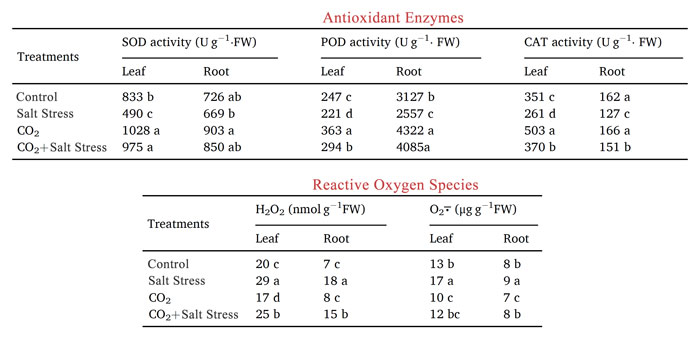| Tweet | Follow @co2science |
Paper Reviewed
Zhang, Y., Yao, Q., Shi, Y., Li, X., Hou, L., Xing, G. and Ahammed, J. 2020. Elevated CO2 improves antioxidant capacity, ion homeostasis, and polyamine metabolism in tomato seedlings under Ca(NO3)2-induced salt stress. Scientia Horticulturae 273: 109644, doi.org/10.1016/j.scienta.2020.109644.
Salt stress is a serious challenge to the growth and yield of crops in many parts of the world. Writing as background for their work, Zhang et al. (2020) note that soil salinization often leads to physiological and metabolic impairments, including "mineral nutrient deficiency, damage to photosynthetic organs, reductions of photosynthetic efficiency, inhibition in plant growth and development, and ultimately yield decline." On the other hand, CO2 enrichment has been shown to lead to numerous physiological and metabolic benefits that improve plant growth and yield. Consequently, it is likely that rising CO2 will help alleviate the negative effects of salt stress on plants in the years and decades to come.
In a test of this hypothesis, Zhang et al. subjected tomato (Solanum lycopersicum, cv. Zhong za 9) seedlings to salt stress under normal (400 ppm) and elevated (800 ppm) CO2 concentrations. The plants were grown in a hydroponic culture in a controlled environment and 80 mmol Ca(NO3)2 was added to simulate moderate soil salinization. After one week of exposure to the different treatments the authors conducted a series of physiological and metabolic measurements to discern if elevated CO2 was able to counter the negative impacts of salt stress.
The results of the experiment showed that elevated CO2 alone increased net photosynthesis and plant dry weight by 21% and 127%, respectively. In contrast, salt stress alone reduced these parameters by approximately 74% and 11%. However, when combined with elevated CO2 the growth retarding effects of salt stress were reduced over that observed for salt stress alone. Indeed, relative to the individual treatment of salt stress, net photosynthesis and plant dry weight values were 86% and 46% higher, revealing a significant alleviation of salt stress. And the good news does not stop there.
CO2 enrichment also alleviated oxidative damage caused by salt stress. Figure 1 presents data showing a CO2-induced increase in antioxidant enzyme concentrations in tomato plant leaves and roots under salt stress, as well as a decrease in harmful reactive oxygen species. Zhang et al. also report "elevated CO2 also differentially modulated the free amino acid concentrations and endogenous polyamine inter-conversion under salt stress, which improved the tolerance of plants to Ca(NO3)2 stress."
Consequently, in light of all the above, the scientists conclude "CO2 enrichment can effectively alleviate the damage of tomato seedlings caused by [salt] stress, and it can be considered as a feasible strategy to manage secondary salinization in [controlled-environment greenhouse] vegetable production."

Figure 1. CO2 enrichment effects on the activity of antioxidant enzymes and reactive oxygen species concentrations in tomato plant leaves and roots under salt stress. Control = 400 ppm CO2 and no salt stress, Salt Stress = 400 ppm CO2 and 80 mmol/L Ca(NO3)2, CO2 = 800 ppm CO2 and no salt stress, CO2+Salt Stress = 800 ppm CO2 and 80 mmol/L Ca(NO3)2. Data within each column followed by the same lowercase letters are not significantly different according to Tukey's test at P < 0.05. Source: Zhang et al. (2020).




